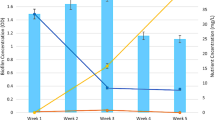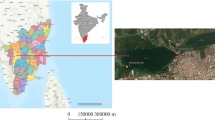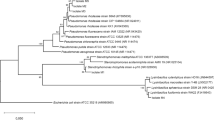Abstract
Microplastic (MP)-colonizing microorganisms are important links for the potential impacts on environmental, health, and biochemical circulation in various ecosystems but are not yet well understood. In addition, biofilms serve as bioindicators for the evaluation of pollutant effects on ecosystems. This study describes the ability of three polyethylene-type microplastics, white (W-), blue (B-), and fluorescent blue (FB-) MPs, to support microbial colonization of Pseudomonas aeruginosa, the effect of mixed organic contaminants (OCs: amoxicillin, ibuprofen, sertraline, and simazine) on plastic-associated biofilms, and the role of biofilms as transfer vectors of such emerging pollutants. Our results showed that P. aeruginosa had a strong ability to produce biofilms on MPs, although the protein amount of biomass formed on FB-MP was 1.6- and 2.4-fold higher than that on B- and W-MP, respectively. When OCs were present in the culture medium, a decrease in cell viability was observed in the W-MP biofilm (65.0%), although a general impairing effect of OCs on biofilm formation was ruled out. Microbial colonization influenced the ability of MPs to accumulate OCs, which was higher for FB-MP. In particular, the sorption of amoxicillin was lower for all bacterial-colonized MPs than for the bare MPs. Moreover, we analysed oxidative stress production to assess the impact of MPs or MPs/OCs on biofilm development. The exposure of biofilms to OCs induced an adaptive stress response reflected in the upregulation of the katB gene and ROS production, particularly on B- and FB-MP. This study improves our understanding of MP biofilm formation, which modifies the ability of MPs to interact with some organic pollutants. However, such pollutants could hinder microbial colonization through oxidative stress production, and thus, considering the key role of biofilms in biogeochemical cycles or plastic degradation, the co-occurrence of MPs/OCs should be considered to assess the potential risks of MPs in the environment.
Graphical Abstract





Similar content being viewed by others
Data availability
The data that support the findings of this study are available from the corresponding author on reasonable request.
References
Ahn S, Jung J, Jang IA, Madsen EL, Park W (2016) Role of glyoxylate shunt in oxidative stress response. J Biol Chem 291(22):11928–11938. https://doi.org/10.1074/jbc.M115.708149
Ashfaq M, Nawaz Khan K, Saif Ur Rehman M, Mustafa G, FaizanNazar M, Sun Q, Iqbal J, Mulla SI, Yu CP (2017) Ecological risk assessment of pharmaceuticals in the receiving environment of pharmaceutical wastewater in Pakistan. Ecotoxicol Environ Saf 136:31–39. https://doi.org/10.1016/j.ecoenv.2016.10.029
Aubertheau E, Stalder T, Mondamert L, Ploy M, Dagot C, Labanowski J (2017) Impact of wastewater treatment plant discharge on the contamination of river biofilms by pharmaceuticals and antibiotic resistance. Sci Total Environ 579:1387–1398. https://doi.org/10.1016/j.scitotenv.2016.11.136
Barbosa F, Adeyemi JA, Bocato MZ, Comas A, Campiglia A (2020) A critical viewpoint on current issues, limitations, and future research needs on micro- and nanoplastic studies: from the detection to the toxicological assessment. Environ Res 182:109089. https://doi.org/10.1016/j.envres.2019.109089
Barra-Caracciolo A, Topp E, Grenni P (2015) Pharmaceuticals in the environment: Biodegradation and effects on natural microbial communities A Review. J Pharm Biomed Anal 106:25–36. https://doi.org/10.1016/j.jpba.2014.11.040
Bhagwat G, O’Connor W, Grainge I, Palanisami T (2021) Understanding the fundamental basis for biofilm formation on plastic surfaces: role of conditioning films. Front Microbiol 12:687118. https://doi.org/10.3389/fmicb.2021.687118
Bhagwat G, Tran TKA, Lamb D, Senathirajah K, Grainge I, O’Connor W, Juhasz A, Palanisami T (2021b) Biofilm enhance the adsorption of toxic contaminants on plastic microfibers under environmentally relevant conditions. Environ Sci Technol 55(13):8877–8887. https://doi.org/10.1021/acs.est.1c02012
Chen XP, Ali L, Wu L-Y, Liu C, Gang CX, Huang QF, Ruan JH, Bao SY, Rao YP, Yu D (2018) Biofilm formation plays a role in the formation of multidrug-resistant Escherichia coli toward nutrients in microcosm experiments. Front Microbiol 9:367. https://doi.org/10.3389/fmicb.2018.00367
Devers M, Soulas G, Martin-Laurent F (2004) Real-time reverse transcription PCR analysis of expression of atrazine catabolism genes in two bacterial strains isolated from soil. J Microbiol Methods 56:3–15. https://doi.org/10.1016/j.mimet.2003.08.015
Dwivedi S, Wahab R, Khan F, Mishra YK, Musarrat J, Al-Khedhairy AA (2014) Reactive oxygen species mediated bacterial biofilm inhibition via zinc oxide nanoparticles and their statistical determination. Plos One 9(11):e111289. https://doi.org/10.1371/journal.pone.0111289
Fajardo C, Martín C, Costa G, Sánchez-Fortún S, Rodríguez C, de Lucas Burneo JJ, Nande M, Mengs G, Martín M (2022) Assessing the role of polyethylene microplastics as a vector for organic pollutants in soil: ecotoxicological and molecular approaches. Chemosphere 288:132460. https://doi.org/10.1016/j.chemosphere.2021.132460
Gong M, Yang G, Zhuang L, Zeng EY (2019) Microbial biofilm formation and community structure on low-density polyethylene microparticles in lake water microcosms. Environ Pollut 252:94–102. https://doi.org/10.1016/j.envpol.2019.05.090
Gornik T, Kovacic A, Heath E, Hollender J, Kosjek T (2020) Biotransformation study of antidepressant sertraline and its removal during biological wastewater treatment. Water Res 181:115864. https://doi.org/10.1016/jwatres.2020.115864
He S, Jia M, Xiang Y, Song B, Xiong W, Cao J, Peng H, Yang Y, Wang W, Yang Z, Zeng G (2022) Biofilm on microplastics in aqueous environment: Physicochemical properties and environmental implications. J Hazard Mater 424:127286. https://doi.org/10.1016/j.jhazmat.2021.127286
He S, Tong J, Xiong W, Xiang Y, Peng H, Wang W, Yang Y, Ye Y, Hu M, Yang Z, Zeng G (2023) Microplastics influence the fate of antibiotics in freshwater environments: biofilm formation and its effect on adsorption behaviour. J Hazard Mater 442:130078. https://doi.org/10.1016/j.jhazmat.2022.130078
Hu M, Palic D (2020) Micro- and nano-plastics activation of oxidative and inflammatory adverse outcome pathways. Redox Biol 37:101620. https://doi.org/10.1016/j.redox.2020.101620
Judy JD, Williams M, Gregg A, Oliver D, Kumar A, Kookana R, Kirby JK (2019) Microplastics in municipal mixed-waste organic outputs induce minimal short to long-term toxicity in key terrestrial biota. Environ Pollut 252:522–531. https://doi.org/10.1016/j.envpol.2019.05.027
Keleştemur S, Çulha M (2017) Understanding and discrimination of biofilms of clinically relevant microorganisms using surface-enhanced Raman scattering. Appl Spectrosc 71(6):1180–1188. https://doi.org/10.1177/00037028166709
Keleştemur S, Avci E, Çulha M (2018) Raman and surface-enhaced Raman scattering for biofilm characterization. Chemosensors 6(1):5. https://doi.org/10.3390/chemosensors6010005
Le TH, Ng C, Tran NH, Chen H, Gin KYH (2018) Removal of antibiotic residues, antibiotic resistant bacteria and antibiotic resistance genes in municipal wastewater by membrane bioreactor systems. Water Res 145:498–508. https://doi.org/10.1016/j.watres.2018.08.060
Li J, Zhang K, Zhang H (2018) Adsorption of antibiotics on microplastics. Environ Pollut 237:460–467. https://doi.org/10.1016/j.envpol.2018.02.050
Lin D, Yang G, Dou P, Qian S, Zhao L, Yang Y, Fanin N (2020) Microplastics negatively affect soil fauna but stimulate microbial activity: insights from a field-based microplastic addition experiment. Proc Biol Sci 287:20201268. https://doi.org/10.1098/rspb.2020.1268
Liu S, Shi J, Wang J, Dai Y, Li H, Li J, Liu X, Chen X, Wang Z, Zhang P (2021) Interactions between microplastics and heavy metals in aquatic environments: a review. Front Microbiol 12:652520. https://doi.org/10.3389/fmicb.2021.652520
Martín C, Fajardo C, Costa G, Sánchez-Fortún S, San Andrés MD, González F, Nande M, Mengs G, Martín M (2021) Bioassays to assess the ecotoxicological impact of polyethylene microplastics and two organic pollutants, simazine and ibuprofen. Chemosphere 274:29704. https://doi.org/10.1016/j.chemosphere.2021.129704
Martínez-Campos S, González-Pleiter M, Fernández-Piñas F, Rosal R, Leganés F (2021) Early and differential bacterial colonization on microplastics deployed into the effluents of wastewater treatment plants. Sci Total Environ 757:143832. https://doi.org/10.1016/j.scitotenv.2020.143832
Meneses CHSG, Rouws LFM, Simões-Araújo JL, Vidal MS, Baldani JI (2011) Exopolysaccharide production is required for biofilm formation and plant colonization by the nitrogen-fixing endophyte Gluconacetobacterdiazotrophicus. Mol Plant Microbe Interact 24:1448–1458. https://doi.org/10.1094/MPMI-05-11-0127
Miao L, Hou J, You G, Liu Z, Liu S, Li T, Mo Y, Guo S, Qu H (2019) Acute effects of nanoplastics and microplastics on periphytic biofilms depending on particle size, concentration and surface modification. Environ Pollut 255:113300. https://doi.org/10.1016/j.envpol.2019.113300
Münze R, Hannemann C, Orlinskiy P, Gunold R, Paschke A, Foit K, Becker J, Kaske O, Paulsson E, Peterson M, Jernstedt H, Kreuger J, Schüürmann G, Liess M (2017) Pesticides from wastewater treatment plant effluents affect invertebrate communities. Sci Total Environ 599–600:387–399. https://doi.org/10.1016/j.scitotenv.2017.03.008
Primet M, Pichat P, Mathieu MV (1971) Infrared study of the surface of titanium dioxides. I Hydroxyl Groups J Phys Chem 75:1216–1220. https://doi.org/10.1021/j100679a007
Qi K, Lu N, Zhang S, Wang W, Wang Z, Guan J (2021) Uptake of Pb(II) onto microplastic-associated biofilms in fresh water: adsorption and combined toxicity in comparison to natural and solid substrates. J Hazard Mater 411:125115. https://doi.org/10.1016/j.jhazmat.2021.125115
Rodriguez-Mozaza S, Vaz-Moreira I, Varela Della Giustina S, Llorca M, Barceló D, Schubert S, Berendonk TU, Michael-Kordatou I, Fatta-Kassinos D, Martinez JL, Elpers C, Henriques I, Jaeger T, Schwartz T, Paulshus E, O’Sullivan K, Pärnänen KMM, Virta M, Do TT, Walsh F, Manaiac CM (2020) Antibiotic residues in final effluents of European wastewater treatment plants and their impact on the aquatic environment. Environ Int 140:105733. https://doi.org/10.1016/j.envint.2020.105733
Rossi F, Cattò C, Mugnai G, Villa F, Forlani F (2021) Effects of the quinone oxidoreductase WrbA on Escherichia coli biofilm formation and oxidative stress. Antioxidants 10:919. https://doi.org/10.3390/antiox10060919
Russo F, Ceci A, Pinzari F, Siciliano A, Guida M, Malusà E, Tartanus M, Miszczak A, Maggi O, Persiani AM (2019) Bioremediation of dichlorodiphenyltrichloroethane (DDT)-contaminated agricultural soils: potential of two autochthonous saprotrophic fungal strains. Appl Environ Microbiol 85(21):e01720-e1819. https://doi.org/10.1128/AEM.01720-19
Sánchez-Fortún A, D’ors A, Fajardo C, Martín C, Nande M, Mengs G, Costa G, Martín M, Sánchez-Fortún S (2022) Influence of contaminant-spiked polyethylene-type microplastics on the growth and primary production of the freshwater phytoplankton species Scenedesmus armatus and Microcystis aeruginosa. Environ Exp Bot 203:105061. https://doi.org/10.1016/j.envexpbot.2022.105061
Simon M, van Alst N, Vollertsen J (2018) Quantification of microplastic mass and removal rates at wastewater treatment plants applying focal plane array (FPA)-based Fourier transform infrared (FT-IR) imaging. Water Res 142:1–9. https://doi.org/10.1016/j.watres.2018.05.019
Sooriyakumar P, Bolan N, Kumar M, Singh L, Yu Y, Li Y, Weralupitiya C, Vithanage M, Ramanayaka S, Sarkar B, Wang F, Gleeson DB, Zhang D, Kirkham MB, Rinklebe J, Siddique KHM (2022) Biofilm formation and its implications on the properties and fate of microplastics in aquatic environments: a review. J Hazard Mate Adv 6:100077. https://doi.org/10.1016/j.hazadv.2022.100077
Strunge K, Madzharova F, Jensen F, Weidner T, Nagata Y (2022) Theoretical sum frequency generation spectra of protein amide with surface-specific velocity–velocity correlation functions. J Phys Chem B 126(42):8571–8578. https://doi.org/10.1021/acs.jpcb.2c04321
Sun J, Dai X, Wang Q, van Loosdrecht MCM, Ni BJ (2019) Microplastics in wastewater treatment plants: detection, occurrence and removal. Water Res 152:21–37. https://doi.org/10.1016/j.watres.2018.12.050
Sun T, Wang S, Ji C, Li F, Wu H (2022) Microplastics aggravate the bioaccumulation and toxicity of coexisting contaminants in aquatic organisms: a synergistic health hazard. J Hazard Mater 424:127533. https://doi.org/10.1016/j.jhazmat.2021.127533
Tagg AS, Sapp M, Harrison JP, Sinclair CJ, Bradley E, Ju-Nam Y, Ojeda JJ (2020) Microplastic monitoring at different stages in a wastewater treatment plant using reflectance micro-FTIR imaging. Front Environ Sci 8:145. https://doi.org/10.3389/fenvs.2020.00145
Tang J, Wu Y, Esquivel-Elizondo S, Sørensen SJ, Rittmann BE (2018) How microbial aggregates protect against nanoparticle toxicity. Trends Biotechnol 6(11):1171–1182. https://doi.org/10.1016/j.tibtech.2018.06.009
Triebskorn R, Braunbeck T, Grummt T, Hanslik L, Huppertsberg S, Jekel M, Knepper T, Krais S, Müller Y, Pittroff M, Ruhl A, Schmieg H, Schür C, Strobel C, Wagner M, Zumbülte N, Köhler HR (2019) Relevance of nano- and microplastics for freshwater ecosystem: a critical review. Trends Analyt Chem 110:375–392. https://doi.org/10.1016/j.trac.2018.11.023
Tu C, Chen T, Zhou Q, Liu Y, Wei J, Waniek JJ, Luo Y (2020) Biofilm formation and its influences on the properties of the microplastics as affected by exposure time and depth in the seawater. Sci Total Environ 734:139237. https://doi.org/10.1016/j.scitotenv.2020.139237
Wang J, Guo X, Xue J (2021) Biofilm-developed microplastics as vectors of pollutants in aquatic environments. Environ Sci Technol 55:12780–12790. https://doi.org/10.1021/acs.est.1c04466
Wen B, Liu J, Zhang Y, Zhang H, Gao J, Chen Z (2020) Community structure and functional diversity of the plastisphere in aquaculture waters: does plastic color matter? Sci Total Environ 740:140082. https://doi.org/10.1016/j.scitotenv.2020.140082
Wu Y, Song Q, Wu J, Zhou J, Zhou L, Wu W (2021) Field study on the soil bacterial associations to combined contamination with heavy metals and organic contaminants. Sci Total Environ 778:146282. https://doi.org/10.1016/j.scitotenv.2021.146282
Xu S, Xing Y, Liu S, Luo X, Chen W, Huang Q (2020) Co-effect of minerals and Cd(II) promoted the formation of bacterial biofilm and consequently enhanced the sorption of Cd(II). Environ Pollut 258:113774. https://doi.org/10.1016/j.envpol.2019.113774
Yang Y, Xu C, Cao X, Lin H, Wang J (2017) Antibiotic resistance genes in surface water of eutrophic urban lakes are related to heavy metals, antibiotics, lake morphology and anthropic impact. Ecotoxicology 26:831–840. https://doi.org/10.1007/s10646-017-1814-3
Zeitler VA, Brown CA (1957) The Infrared Spectra of Some Ti-O-Si, Ti-O-Ti and Si-O-Si Compounds. J Phys Chem 61:1174–1177. https://doi.org/10.1021/j150555a010
Zhang HY, Zhang C, Rao W, Zhang H, Liang G, Deng X, Zhao J, Guan Y, Ying G (2022) Influence of biofilms on the adsorption behaviour of nine organic emerging contaminants on microplastics in field-laboratory exposure experiments. J Hazard Mater 434:128895. https://doi.org/10.1016/j.jhazmat.2022.128895
Coates J (2006) Interpretation of infrared spectra, a practical approach. In Encyclopedia of Analytical Chemistry (eds R.A. Meyers and M.L. McKelvy). https://doi.org/10.1002/9780470027318.a5606
Geyer R (2020) Chapter 2 – Production, use, and fate of synthetic polymers. In: Letcher TM (ed) Plastic Waste and Recycling, Academic Press, Cambridge, MA, pp. 13–32. https://doi.org/10.1016/b978-0-12-817880-5.00002-5
PlasticsEurope (2020) Plastics – The Facts 2020. An analysis of European plastics production, demand and waste data. Belgium.
Funding
The authors thank the Spanish Ministry of Science, Innovation and Universities for supporting Project CTM2017-82424-P and the University of Alcala for supporting Project CCG20/CC-040. Diogo Videira-Quintela was supported by a FPI fellowship from the University of Alcalá and by the Margarita Salas fellowship from the Spanish Ministry of Universities and EU-Next Generation.
Author information
Authors and Affiliations
Contributions
Carmen Fajardo: conceptualization, methodology, formal analysis, investigation, writing—original draft, and writing—review and editing. Sebastian Sánchez-Fortún: methodology, formal analysis, investigation, and writing—original draft. Diogo Videira-Quintela: methodology, formal analysis, investigation, and writing—original draft. Carmen Martín: formal analysis, investigation, and writing—original draft. Mar Nande: methodology and formal analysis. Ana D´ors: methodology, formal analysis, and investigation. Gonzalo Costa: conceptualization and writing—original draft. Francisco Guillén: methodology, formal analysis, and investigation. Gemma Montalvo: investigation and writing—original draft. Margarita Martin: conceptualization, supervision, project administration, funding acquisition, and writing—original draft.
Corresponding author
Ethics declarations
Ethics approval
The work did not generate negative impacts on the environment. No current bioethical standards were violated.
Consent to participate
Author and all co-authors agree to submit the present research work in the previously mentioned journal and disclose that it has not been published previously and that it is not under consideration for publication elsewhere.
Consent for publication
Author and all co-authors agree to publish the present research work in the journal.
Conflict of interest
The authors declare no competing interests.
Additional information
Responsible Editor: Robert Duran
Publisher's note
Springer Nature remains neutral with regard to jurisdictional claims in published maps and institutional affiliations.
Highlights
• P. aeruginosa had a strong ability to produce biofilms on PE-MPs.
• The extent of microbial colonization varied with the characteristics of the MP.
• MP-associated biofilms influenced the adsorption of environmental pollutants.
• Exposure of biofilms to environmental pollutants increased oxidative stress.
• Biofilm is an effective antioxidant defence for bacteria.
Supplementary Information
Below is the link to the electronic supplementary material.
Rights and permissions
Springer Nature or its licensor (e.g. a society or other partner) holds exclusive rights to this article under a publishing agreement with the author(s) or other rightsholder(s); author self-archiving of the accepted manuscript version of this article is solely governed by the terms of such publishing agreement and applicable law.
About this article
Cite this article
Fajardo, C., Sánchez-Fortún, S., Videira-Quintela, D. et al. Biofilm formation on polyethylene microplastics and their role as transfer vector of emerging organic pollutants. Environ Sci Pollut Res 30, 84462–84473 (2023). https://doi.org/10.1007/s11356-023-28278-2
Received:
Accepted:
Published:
Issue Date:
DOI: https://doi.org/10.1007/s11356-023-28278-2




